World War II marked a transformative era in aerial combat, highlighting the vital interplay of tactics, technology, and training. The lessons learned from this period not only shaped the strategies of the time but continue to inform modern military aviation practices. By examining the advancements and insights gained from WWII, contemporary air forces can enhance their operational effectiveness and adapt to evolving challenges in aerial warfare.
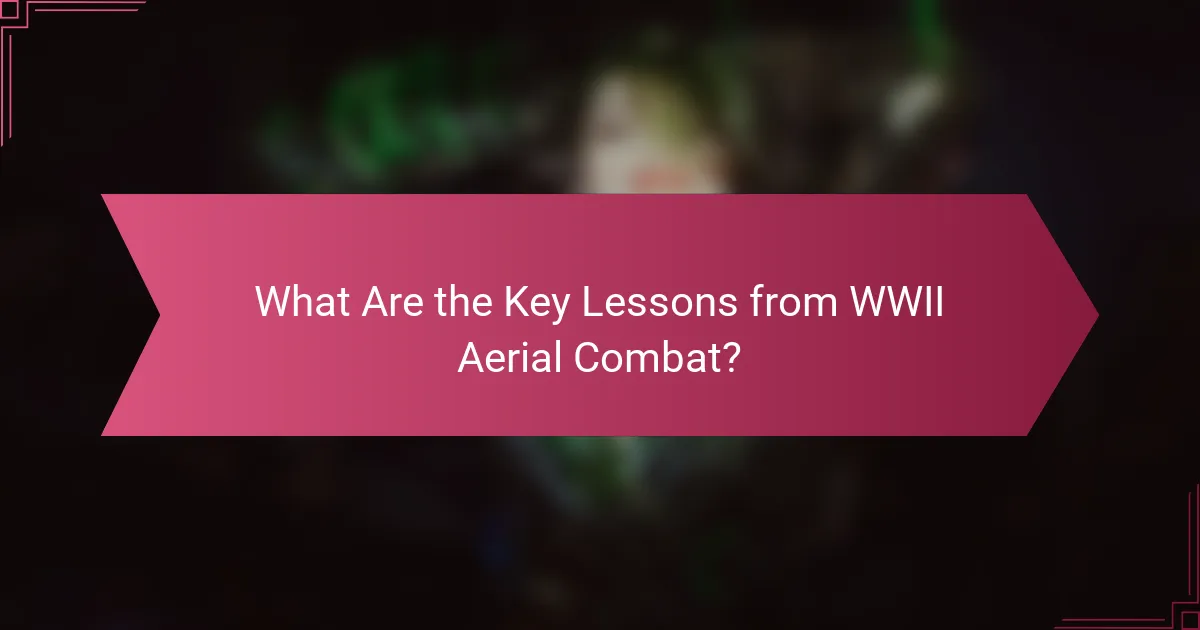
What Are the Key Lessons from WWII Aerial Combat?
The key lessons from WWII aerial combat include the critical importance of tactics and strategy, the role of technological advancements, the impact of pilot training, the significance of intelligence and reconnaissance, and insights gained from successful missions. These elements shaped air warfare and continue to influence modern military aviation practices.
Importance of tactics and strategy
Tactics and strategy were vital in WWII aerial combat, determining the success of missions and the effectiveness of air forces. Commanders developed specific approaches based on enemy capabilities, terrain, and objectives, often adapting in real-time to changing conditions. For example, the use of coordinated attacks, such as the Blitzkrieg strategy, showcased how effective tactics could overwhelm opponents.
Understanding the battlefield dynamics and employing flexible strategies allowed air forces to exploit weaknesses and achieve air superiority. Modern military operations still emphasize the need for strategic planning and tactical flexibility to adapt to evolving threats.
Role of technology advancements
Technological advancements significantly influenced WWII aerial combat, introducing innovations such as radar, improved aircraft designs, and weaponry. The development of long-range bombers and faster fighters changed the landscape of air warfare, allowing for more effective strikes and defensive measures. Technologies like radar enhanced situational awareness, enabling better tracking of enemy movements.
Today, military aviation continues to evolve with advancements in stealth technology, unmanned aerial vehicles (UAVs), and precision-guided munitions. Understanding the historical impact of these technologies helps inform current and future developments in aerial combat capabilities.
Impact of pilot training
Pilot training was a crucial factor in the effectiveness of air forces during WWII. Well-trained pilots could execute complex maneuvers and make quick decisions under pressure, which often determined the outcome of dogfights. Training programs focused on both technical skills and tactical awareness, preparing pilots for the realities of combat.
Modern military forces emphasize rigorous training regimens, including simulations and real-world exercises, to ensure pilots are equipped to handle diverse scenarios. Continuous training remains essential for maintaining high levels of proficiency and adaptability in aerial operations.
Significance of intelligence and reconnaissance
Intelligence and reconnaissance played a pivotal role in WWII aerial combat, providing critical information about enemy positions, strengths, and movements. Effective reconnaissance missions allowed air forces to plan strikes with greater accuracy and minimize risks. The use of aerial photography and signals intelligence became standard practices for gathering actionable data.
In contemporary military operations, the integration of intelligence and reconnaissance continues to be vital. Modern technologies, such as satellite imagery and real-time data analysis, enhance situational awareness and inform strategic decisions, underscoring the enduring importance of intelligence in aerial combat.
Case studies of successful missions
Analyzing case studies of successful missions from WWII reveals valuable insights into effective aerial combat strategies. Operations like the Doolittle Raid demonstrated the importance of surprise and morale-boosting strikes, while the Battle of Britain highlighted the significance of air superiority in defending against enemy attacks.
These historical examples provide lessons in planning, execution, and adaptability that are applicable to modern military operations. By studying past successes, current air forces can refine their tactics and strategies to meet contemporary challenges in aerial warfare.
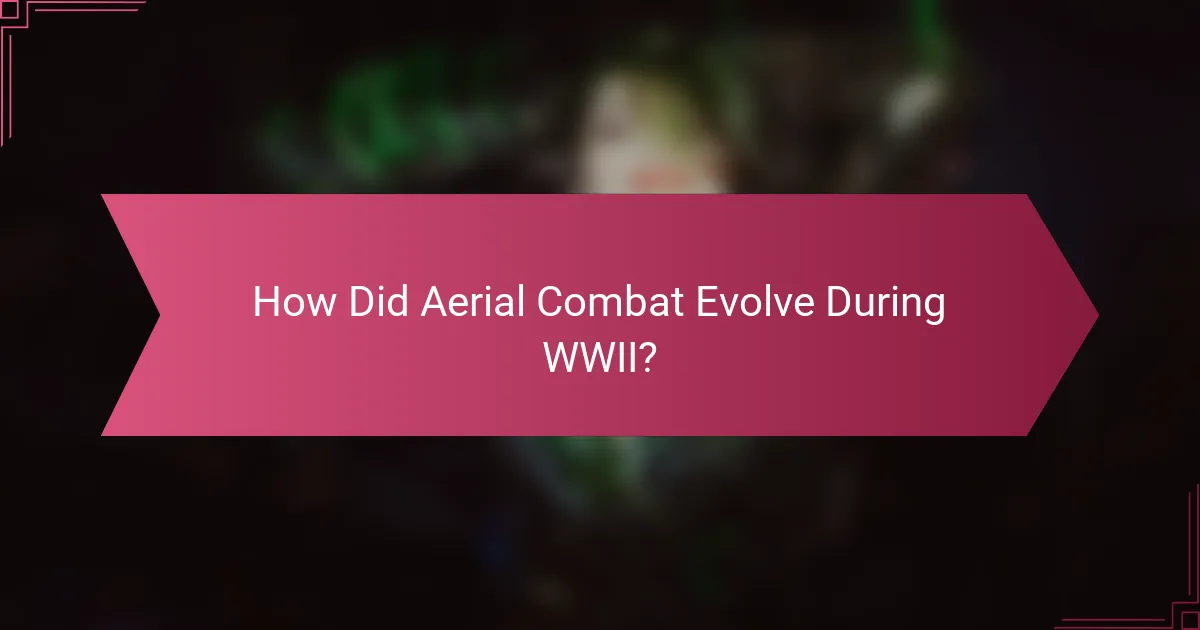
How Did Aerial Combat Evolve During WWII?
Aerial combat evolved significantly during World War II, driven by advancements in technology and changing military strategies. Key developments included the enhancement of fighter aircraft capabilities, the introduction of strategic bombing, and the refinement of dogfighting techniques.
Development of fighter aircraft
The development of fighter aircraft during WWII focused on speed, agility, and firepower. Early models like the Spitfire and Mustang showcased improved aerodynamics and engine performance, allowing for greater maneuverability in combat. By the war’s end, fighters were equipped with powerful cannons and machine guns, enhancing their effectiveness against enemy bombers.
Manufacturers prioritized lightweight materials and advanced designs, leading to iconic models such as the P-51 Mustang and the Messerschmitt Bf 109. These advancements allowed for higher operational ceilings and longer ranges, enabling fighters to engage in more dynamic combat scenarios.
Introduction of bomber strategies
Bomber strategies evolved to target enemy infrastructure and military assets, shifting the focus from purely tactical engagements to strategic bombing campaigns. The Allies employed heavy bombers like the B-17 Flying Fortress and the Lancaster to conduct daylight raids, aiming to cripple industrial capacity and morale.
These strategies emphasized precision bombing, although early efforts often resulted in significant collateral damage. The introduction of the Norden bombsight aimed to improve accuracy, but challenges remained, leading to a mix of strategic and area bombing approaches throughout the conflict.
Changes in aerial dogfighting techniques
Aerial dogfighting techniques transformed as pilots adapted to new aircraft capabilities and combat scenarios. Tactics shifted from head-on attacks to more strategic maneuvers, such as the use of the “boom and zoom” technique, where pilots would dive on an enemy and then climb away to avoid return fire.
Training programs became more sophisticated, emphasizing teamwork and situational awareness. The emergence of radar technology also influenced dogfighting, allowing pilots to detect enemy aircraft at greater distances, which changed engagement strategies and improved survival rates in combat.
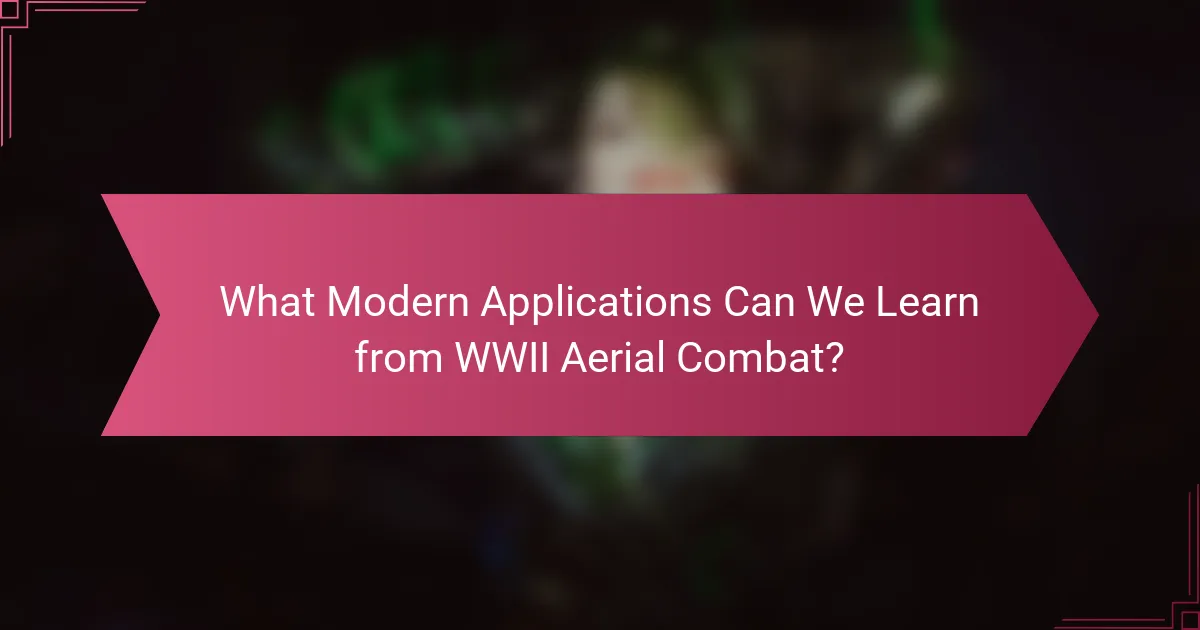
What Modern Applications Can We Learn from WWII Aerial Combat?
Modern applications of WWII aerial combat emphasize the importance of strategic training, advanced simulation technologies, and lessons that inform contemporary air force strategies. By analyzing historical tactics and technologies, military forces can enhance their operational effectiveness today.
Military training programs
Military training programs today can draw significant insights from WWII aerial combat, particularly in the emphasis on teamwork and adaptability. Training should incorporate realistic scenarios that mimic the complexities faced by pilots during the war, fostering quick decision-making and collaboration among crew members.
Incorporating lessons from WWII, such as the importance of communication and situational awareness, can enhance pilot readiness. Programs should include joint exercises that simulate multi-role operations, allowing pilots to experience real-time challenges similar to those encountered in historical conflicts.
Simulation technologies in aviation
Simulation technologies have advanced significantly since WWII, allowing for immersive training experiences that replicate aerial combat scenarios. Modern flight simulators can create detailed environments that reflect various weather conditions, enemy tactics, and mission objectives, providing pilots with valuable practice without the risks associated with actual flight.
These technologies can also be used for debriefing sessions, where pilots analyze their performance and decision-making processes. By integrating data analytics, simulators can offer personalized feedback, helping pilots refine their skills and strategies based on historical outcomes from WWII engagements.
Lessons for modern air force strategies
Modern air force strategies can benefit from lessons learned during WWII, particularly in the areas of strategic bombing and air superiority. The emphasis on achieving air dominance early in a conflict remains relevant, as it allows for greater operational flexibility and protection of ground forces.
Additionally, understanding the importance of intelligence and reconnaissance, as demonstrated in WWII, is critical for contemporary operations. Modern air forces should prioritize gathering and analyzing data to inform tactical decisions, ensuring they remain one step ahead of adversaries in dynamic combat environments.
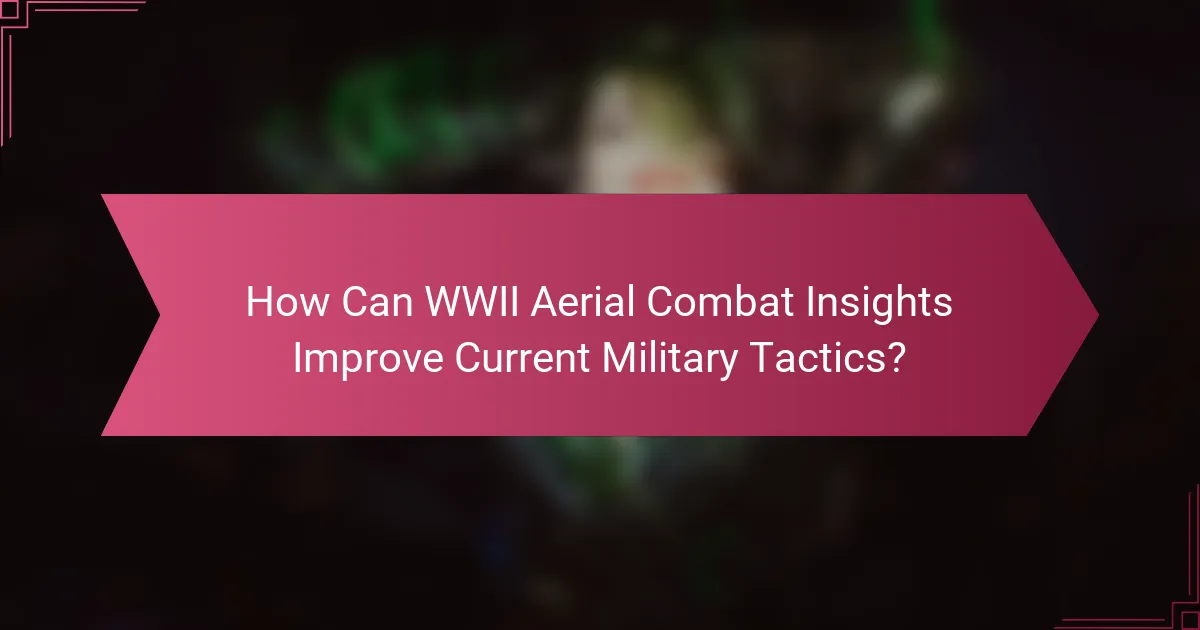
How Can WWII Aerial Combat Insights Improve Current Military Tactics?
Insights from WWII aerial combat can significantly enhance current military tactics by emphasizing the importance of strategic planning, adaptability, and the integration of technology. By studying historical successes and failures, modern forces can refine their approaches to aerial engagements.
Adapting historical strategies to modern warfare
Many strategies employed during WWII, such as the use of coordinated attacks and the element of surprise, remain relevant today. Modern military forces can adapt these tactics by incorporating real-time intelligence and joint operations across different branches of the military.
For example, the concept of “swarm tactics,” where multiple units engage simultaneously to overwhelm an opponent, can be traced back to WWII dogfighting techniques. Implementing these strategies requires thorough training and simulations to ensure effective execution in contemporary scenarios.
Integrating technology with traditional tactics
The integration of advanced technology, such as drones and precision-guided munitions, with traditional aerial combat tactics can enhance effectiveness. Modern militaries should focus on how to leverage these technologies while maintaining the core principles of aerial strategy learned from WWII.
For instance, using drones for reconnaissance can provide critical information that informs tactical decisions, allowing for more effective planning and execution of air missions. However, it’s essential to avoid over-reliance on technology, ensuring that pilots and commanders remain skilled in fundamental tactics and decision-making processes.
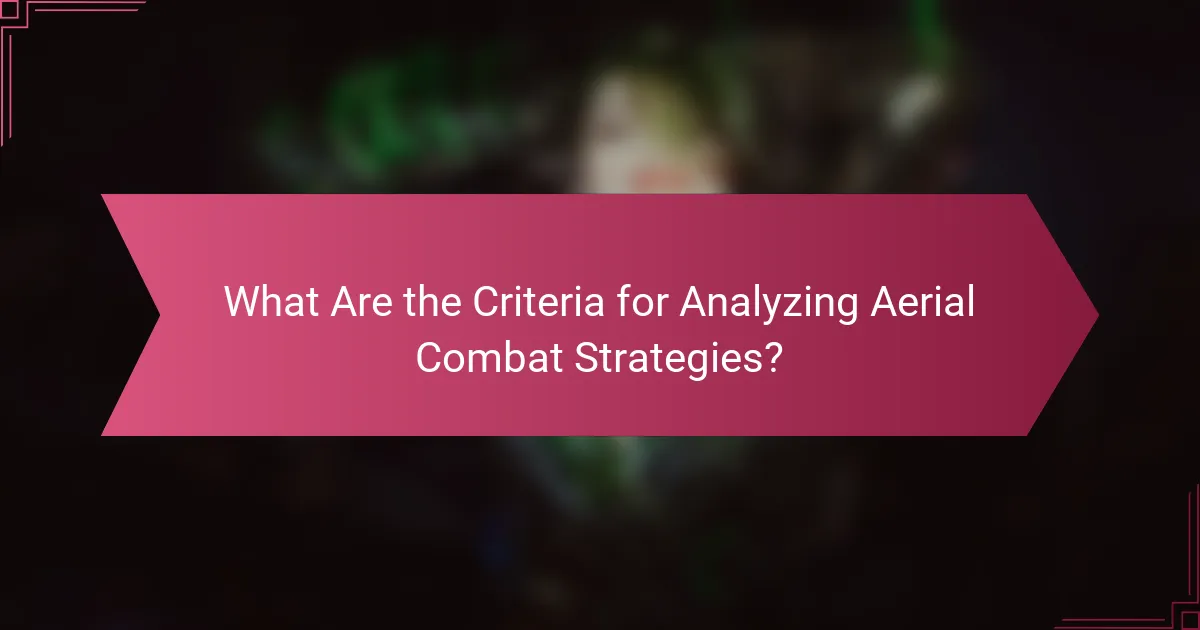
What Are the Criteria for Analyzing Aerial Combat Strategies?
Analyzing aerial combat strategies involves evaluating the effectiveness of tactics, assessing aircraft performance, and evaluating pilot effectiveness. These criteria help in understanding the strengths and weaknesses of different approaches used during combat, providing insights for modern applications.
Effectiveness of tactics
The effectiveness of tactics in aerial combat can be assessed by examining their success rates in various engagements. Key factors include the element of surprise, coordination among units, and adaptability to changing conditions. For instance, tactics that emphasize high-speed maneuvers may be more effective against slower aircraft.
Common pitfalls include over-reliance on a single tactic or failing to adapt to the enemy’s strategies. A successful approach often involves a mix of offensive and defensive maneuvers tailored to the specific combat scenario.
Assessment of aircraft performance
Aircraft performance is crucial in aerial combat analysis, focusing on speed, maneuverability, and armament. Evaluating these aspects helps determine which aircraft are best suited for particular missions. For example, fighter jets with high thrust-to-weight ratios tend to excel in dogfights, while bombers may prioritize payload capacity.
It is essential to compare aircraft specifications against operational requirements. Factors such as range, service ceiling, and combat radius should be considered to ensure that the chosen aircraft can effectively execute its mission.
Evaluation of pilot effectiveness
Evaluating pilot effectiveness involves assessing skills such as situational awareness, decision-making, and reaction times. Experienced pilots often demonstrate superior performance in high-pressure situations, making their training and background critical factors in combat success. For example, pilots trained in simulated dogfights may react more swiftly than those with limited practice.
To enhance pilot effectiveness, regular training and realistic simulations are vital. Implementing a feedback loop where pilots can learn from both successes and failures can significantly improve overall performance in aerial combat scenarios.

What Are the Future Trends in Aerial Combat?
The future of aerial combat is increasingly defined by advancements in technology, including unmanned systems and artificial intelligence. These innovations are reshaping tactics and strategies, emphasizing speed, precision, and networked operations.
Increased Use of Unmanned Aerial Vehicles (UAVs)
Unmanned Aerial Vehicles (UAVs) are becoming central to modern aerial combat, providing reconnaissance, surveillance, and strike capabilities without risking pilot lives. Their ability to operate in contested environments allows for greater operational flexibility.
UAVs can be deployed in various roles, from intelligence gathering to precision strikes. Countries are investing in both armed and unarmed drones, with some military forces planning to integrate swarms of UAVs to overwhelm enemy defenses.
Integration of Artificial Intelligence
Artificial intelligence (AI) is transforming aerial combat by enhancing decision-making processes and automating complex tasks. AI systems can analyze vast amounts of data in real-time, improving situational awareness and targeting accuracy.
For example, AI can assist in identifying threats and coordinating responses among multiple aircraft, reducing reaction times significantly. However, reliance on AI also raises concerns about cybersecurity and the ethical implications of autonomous weapon systems.
Network-Centric Warfare
Network-centric warfare emphasizes the importance of connectivity among various military assets, including aircraft, ground forces, and naval units. This approach facilitates real-time data sharing and coordinated operations, enhancing overall combat effectiveness.
Future aerial combat will likely involve integrated systems where aircraft communicate seamlessly with other platforms, enabling rapid responses to emerging threats. This interconnectedness requires robust communication networks and cybersecurity measures to prevent disruptions.
Stealth and Counter-Stealth Technologies
Stealth technology continues to be a critical factor in aerial combat, allowing aircraft to evade detection by enemy radar systems. As adversaries develop advanced detection capabilities, the arms race between stealth and counter-stealth technologies intensifies.
Future combat scenarios will likely see the deployment of next-generation stealth aircraft alongside advanced radar and missile systems designed to detect and engage these elusive targets. Maintaining a technological edge in stealth capabilities will be essential for air superiority.
